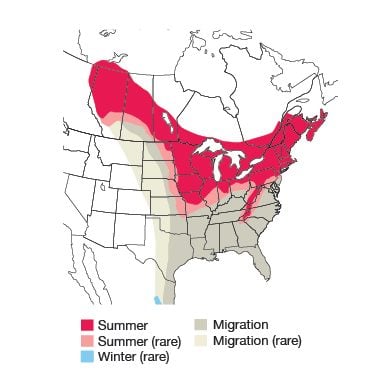Identify and Attract a Rose-Breasted Grosbeak
Updated: Nov. 02, 2023
Learn what a male, female and juvenile rose breasted grosbeak looks like, what their song sounds like, what they eat and how to attract them.
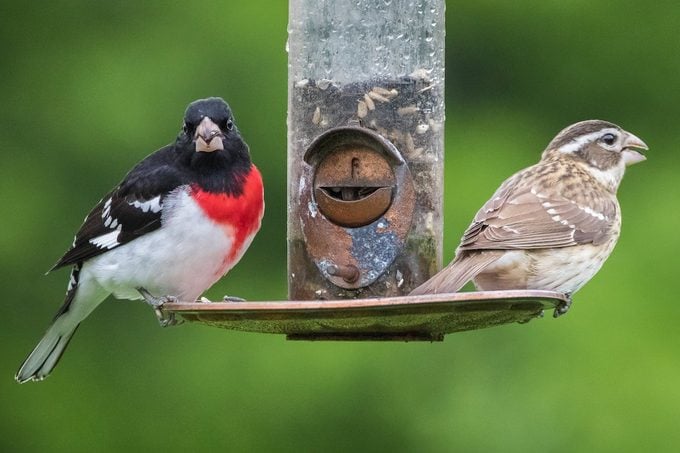
Male Rose-Breasted Grosbeak
To some birders, spotting a rose-breasted grosbeak is a definite sign of spring. Rose-breasted grosbeaks show up east of the Rockies in spring. Males are dressed to the nines in black and white with a red ascot-like marking on their chests. Their bold feathers make them easy to identify. These birds measure about 8 inches long with a 12 1/2 inch wingspan.
Check out 5 types of grosbeaks backyard birders should know.
Female Rose-Breasted Grosbeak
Females sport a more subtle look and are harder to identify because of their drab coloring. They are brown and white with a striped breast and a dark cheek patch. Look for long white stripes above their eyes on a heavily streaked brown body with yellowish underwings. As different as they are, both share one easily recognizable feature: thick conical bills.
Don’t miss these outstanding pictures of rose-breasted grosbeaks.
Nests and Eggs
Pairs build a lightly woven cup shaped nests made of twigs, grasses and leaves. From late spring to summer, the female lays up to five bluish or greenish speckled eggs. Rose-breasted grosbeaks build their nests so loosely that the eggs they lay can occasionally be spotted through the bottom.
A nest is usually located on a tree branch 5 to 20 feet off the ground, but sometimes can be much higher and closer to the forest canopy. “Rose-breasted grosbeak nests are often very high in trees, so they can be hard to spot from the ground,” says Emma Greig, a project leader for the Cornell Lab of Ornithology’s citizen science program Project FeederWatch.
Both males and females spend time incubating the eggs and then quietly sing to each other. Eggs hatch in about 13 days under the watchful eyes of both parents. If a pair raises a second brood, the male may take charge of the first while his mate sits on the new eggs. Males and females share incubation, brooding and feeding duties.
Get to know gorgeous blue grosbeaks.
Juvenile Rose-Breasted Grosbeak
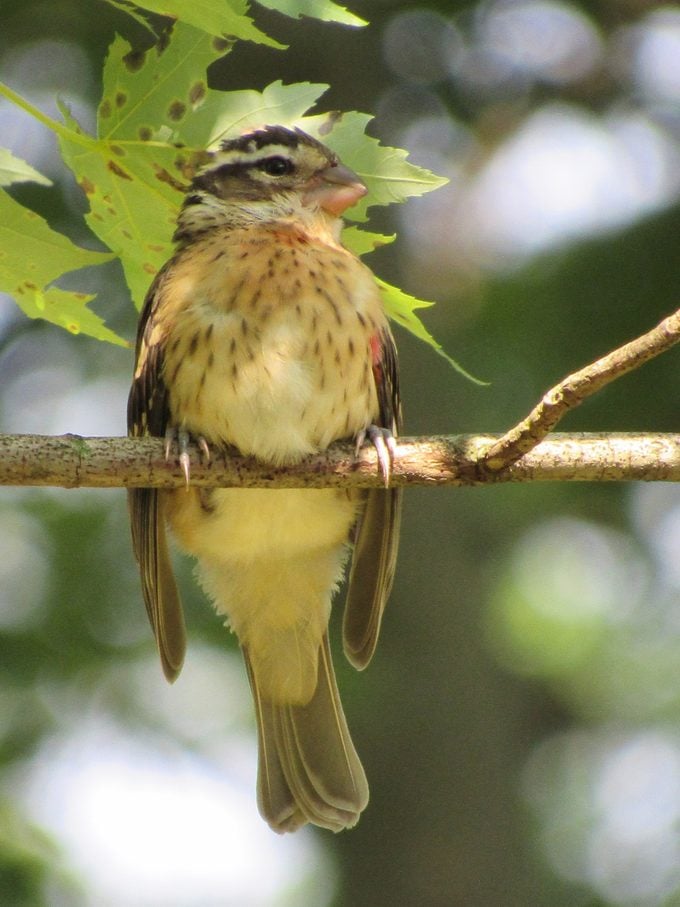
Immature birds are brown and heavily streaked. Young males look like a blend of a female and male with a white eyebrow and a less visible chest patch. Within two weeks, the chicks leave the nest.
Learn how to identify baby orioles and juvenile orioles.
What Does a Rose-Breasted Grosbeak Eat?
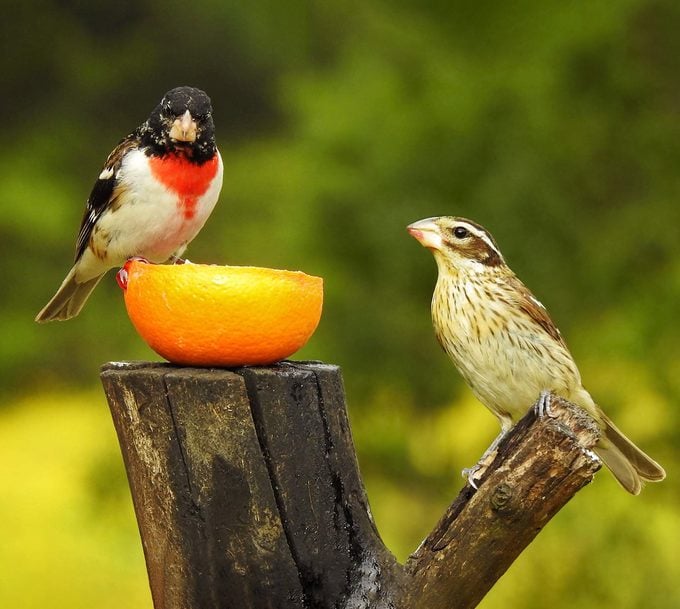
Rose-breasted grosbeaks mostly stick to foraging for insects, seeds and fruit in the foliage of trees, but they will come to backyard feeders. Make sure your feeders are full during migration months, when they’ll need the most energy. Draw in these timid, stocky birds by setting up several feeders filled with birdseed or peanuts. Be sure to provide generous perching room. “A great way to attract rose-breasted grosbeaks to your yard is to offer black oil sunflower seeds in a platform, hopper or large tube feeder,” Emma says.
Ensure that the young get a healthy start by offering a habitat filled with native plants that attracts a steady diet of insects. “Even though adult rose-breasted grosbeaks love seeds and berries, their young are fed mostly insects,” says Emma. “This is because the young need the extra protein for their growth.”
I have fed orioles for years but had an awesome surprise the day I took this photo (above). I was thrilled when rose-breasted grosbeaks showed up,” says Pam Garcia.
Did you know: evening grosbeaks and pine grosbeaks are special winter visitors.
Attract Rose-Breasted Grosbeaks With Plants
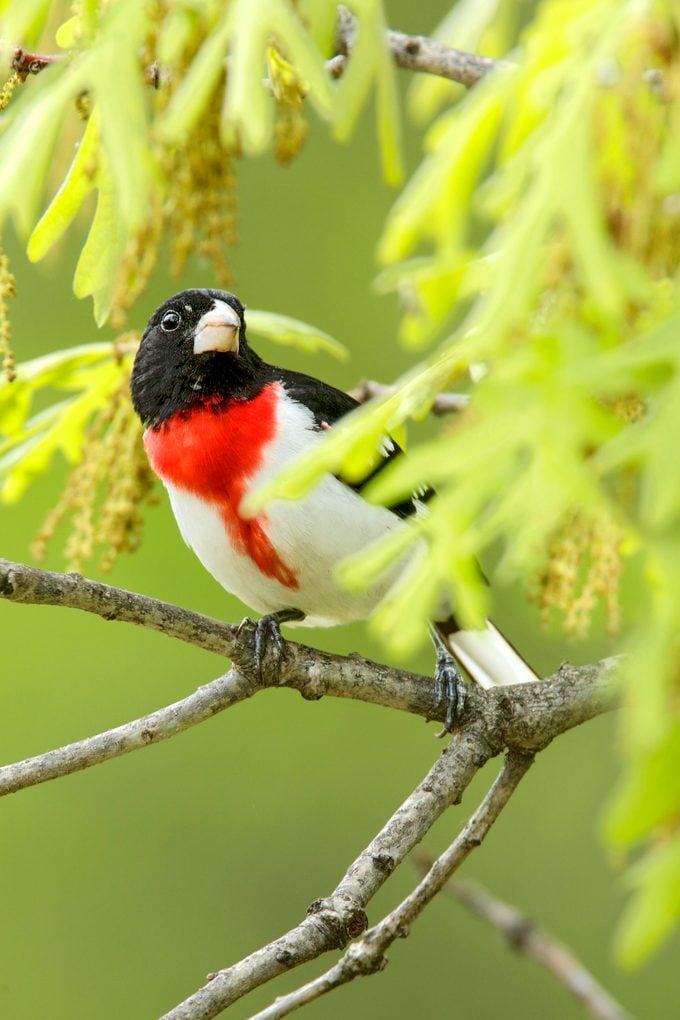
You’ll have a better chance of attracting these fliers if you plant berry-producing trees and shrubs.
- American elderberry
- Arrowwood viburnum
- Blueberries
- Flowering dogwood
- Mountain ash
- Red mulberry
- Serviceberry
- Virginia creeper
Rose-Breasted Grosbeak Song
Their song is similar to an American robin’s whistle, but faster and more musical. Upon arriving around May from their wintering grounds in Mexico, Central America and northern South America, these songbirds kick off courtship. The males’ melodies are designed to attract mates, claim territory and warn off competitors. Males are known to sing more than 650 times per day. The male’s courtship dance can consist of the head tipped back and tail spread out and held upright while the bird flashes its rose-colored underwings.
Bird songs provided by the Cornell Lab of Ornithology.
Habitat and Range Map
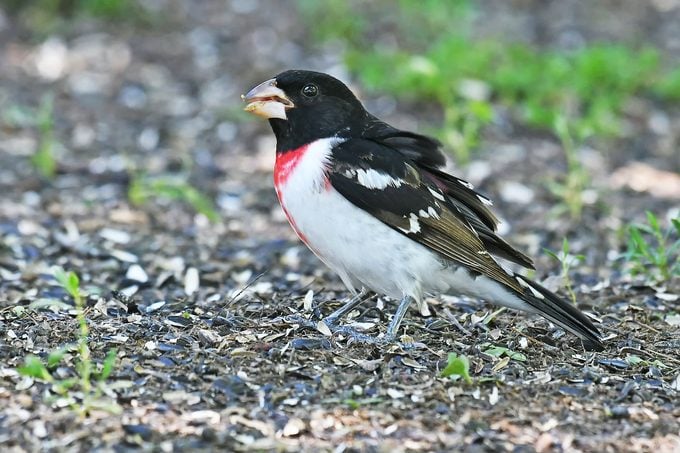
Look for these birds in deciduous and mixed woods, also well-wooded residential areas and parks. They are primarily spotted in the eastern half of the country and are summer residents in northern states. Interestingly, they cross paths and sometimes mate with black-headed grosbeaks in the Great Plains, resulting in hybrid offspring.
Birds & Blooms reader Neil Farrell spotted this bird outside of its normal range and asked our experts about the sighting. “A male rose-breasted grosbeak appeared in my California backyard last May. How’d he get here?”
Kenn and Kimberly Kaufman say, “Rose-breasted grosbeaks are mostly eastern birds, spending the summer in the northeastern U.S. and eastern Canada, and wintering from Mexico south through Central America to northern South America. Their main migration routes are east of the Rocky Mountains. But every year some stray from the normal routes used during spring and fall migrations, and they show up at scattered sites throughout the western states. This seems to happen most often in spring, probably involving birds that go off course as they move north out of Mexico.
Range maps provided by Kaufman Field Guides, the official field guide of Birds & Blooms.

